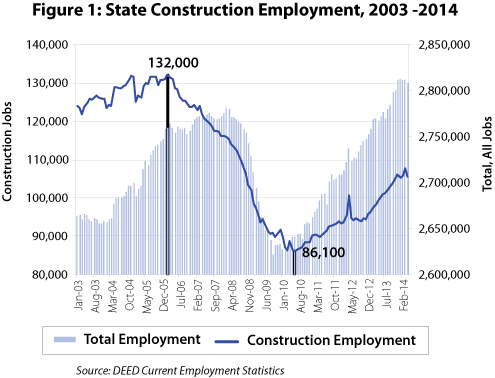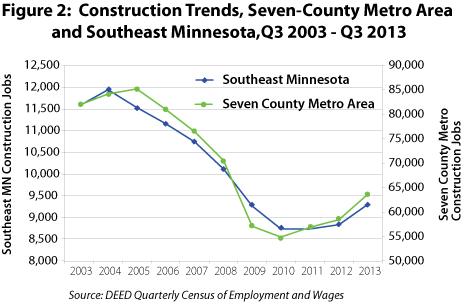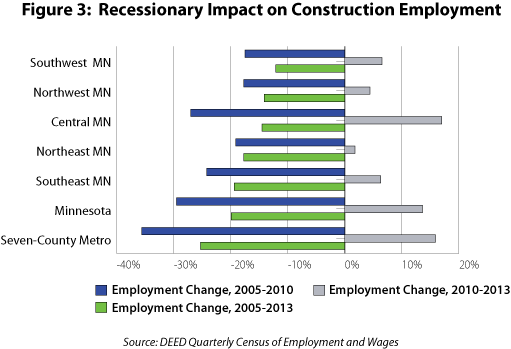
by Tim O'Neill
June 2014
Construction employment in the Twin Cities and southeastern Minnesota is recovering after hitting the skids during the recession.
Building is the name of the game when it comes to the construction industry. Lately, however, rebuilding might be a better way to characterize the construction sector. The recession in Minnesota had a heavy impact on construction projects and employment. The housing bubble, after all, sparked the recession. Since 2010, however, construction has begun to re-emerge as a significant industry in Minnesota. Within the seven-county metro area and southeastern Minnesota, current and upcoming projects promise to keep construction workers busy into the foreseeable future.
Statewide, construction employment hit a seasonally-adjusted pre-recessionary peak of 132,000 jobs in February 2006. Over the next 52 months, construction employment would plummet by 45,900 jobs (34.8 percent). Comparatively, total employment for all industries in Minnesota declined by 4.3 percent during the same period. By June 2010, the state was down to 86,100 construction workers, a level of employment not witnessed since 1995.
Fortunately, construction employment has been gradually rebuilding within the last 46 months. As of April 2014, Minnesota had a seasonally-adjusted 106,000 construction workers. This represents a boost of 19,900 workers from the low point in June 2010, an increase of 23.1 percent.
To put this growth in perspective, professional and business services had the second-highest employment growth at 11.3 percent during the same period. Overall, total employment growth statewide was 6.3 percent. While construction employment is still 26,500 jobs below its pre-recessionary peak, recent trends are encouraging (see Figure 1).

To analyze employment at the regional level, we looked at data from the Quarterly Census of Employment and Wages. This is a comprehensive dataset covering about 97 percent of total state employment.
In third quarter 2013, Minnesota had 16,448 covered construction establishments with 121,657 jobs. More than half of these jobs, 63,634, were located in the seven-county metro area. Another 9,299 construction jobs were in the 11 counties of southeastern Minnesota.
As such, three out of every five construction workers in the state work in either the metro or southeastern Minnesota. This is despite construction representing a smaller share of all jobs in those two areas than other regions and the state overall (see Table 1).
| Construction Employment in Minnesota Sorted by Employment, 3Q 2013 | ||||
|---|---|---|---|---|
| Area | Establishments | Employment | Percent of Total Employment | Average Annual Wage |
| Minnesota | 16,448 | 121,657 | 4.5% | $56,160 |
| Seven-County Metro Area | 6,505 | 63,634 | 3.9% | $61,256 |
| Central | 2,677 | 16,478 | 6.3% | $53,300 |
| Northwest | 2,137 | 11,911 | 5.5% | $47,684 |
| Southeast | 1,458 | 9,299 | 3.9% | $48,516 |
| Southwest | 1,511 | 8,796 | 5.1% | $45,188 |
| Northeast | 1,002 | 6,674 | 4.7% | $50,388 |
| Source: DEED Quarterly Census of Employment and Wages (QCEW) Program | ||||
Based on quarterly data, employment hit its pre-recessionary peak during the fourth quarter of 2007 in Minnesota. Construction, however, had already begun to show signs of significant decline throughout the state.
The metro and southeast both hit their respective pre-recessionary highs of 85,221 and 11,540 construction workers during the third quarter of 2005. Between the third quarters of 2005 and 2010, construction employment within the metro dropped by 36 percent, the largest margin of any region in the state. Construction employment in southeastern Minnesota fell by 24 percent, shedding nearly 2,800 jobs over that period. Figure 2 shows the drop in the two regions, while Figure 3 shows that these two regions were not alone in this regard.


Fortunately, construction employment in the metro and southeastern Minnesota has joined the rest of the state in showing positive signs of recovery since 2010. In fact, between the third quarters of 2010 and 2013, the metro area added back 8,710 construction jobs, nearly 60 percent of all state construction employment recovered since 2005. Southeastern Minnesota has added 554 construction jobs since 2005 and currently sits at about 9,300 total jobs (see Table 2).
| Regional Construction Industry Statistics Quarter 3, 2005 - 2013 | |||||
|---|---|---|---|---|---|
| Area | Employment | Q3, 2005 - Q3, 2013 | Q3, 2010 - Q3, 2013 | ||
| Numeric | Percent | Numeric | Percent | ||
| Minnesota | 121,657 | -30,188 | -19.9% | 14,553 | 13.6% |
| Seven-County Metro Area | 63,634 | -21,587 | -25.3% | 8,710 | 15.9% |
| Central | 16,478 | -2,802 | -14.5% | 2,396 | 17.0% |
| Northwest | 11,911 | -1,952 | -14.1% | 507 | 4.4% |
| Southeast | 9,299 | -2,241 | -19.4% | 554 | 6.3% |
| Southwest | 8,796 | -1,214 | -12.1% | 539 | 6.5% |
| Northeast | 6,674 | -1,432 | -17.7% | 116 | 1.8% |
| Source: DEED Quarterly Census of Employment and Wages (QCEW) | |||||
DEED industry projections show construction employment in the state growing by 39 percent between 2010 and 2020, the fastest growth of any major industrial sector. Within the metro and southeastern Minnesota, construction is projected to grow by 38 percent and 40 percent, respectively. Only central Minnesota shows higher projections, at 52 percent growth.
In light of recent news for the metro and southeast, it would seem that these areas are well on their way toward meeting these projections. Within the metro, several large projects are planned or underway that promise to bolster the need for construction workers. The Green Line light rail project, for instance, has been the largest public works project in state history. While construction on the Green Line is finished after three years of work, investment along the line for new and renovated commercial and housing projects, has already topped $2.5 billion.1 Other projects and news worthy of attention include:
The Minnesota Legislature recently approved a $1 billion public works package that will pump funding into state college and university building projects, parks and trails, prisons, hospitals, roads, bridges, and dozens of economic development projects sought by cities and counties throughout the state. Notable projects include the restoration of the state Capitol, a makeover for Target Center and a redesign of Nicollet Mall.
The $1 billion Vikings stadium is underway in downtown Minneapolis.
A $400 million development near the new Vikings stadium will bring offices, new retail and apartments.2
A$5 billion Destination Medical Center in Rochester is expected to bring a surge in new home construction.3
The Federal Reserve Bank of Minneapolis recently reported that Minnesota construction and land development loans increased by almost 7 percent in 2013 to nearly $2 billion, illustrating increased construction activity locally.4
And let's not forget seasonal road construction.
With so many construction projects planned or underway, and projections showing robust numbers through 2020, the need for construction workers will be high in many parts of the state. Based on the latest Job Vacancy Survey, from the fourth quarter of 2013, there were 567 and 464 construction vacancies reported within the metro and southeastern Minnesota, respectively. Combined, vacancies for these two areas are up 250 percent from the previous year, indicating a strong demand for construction workers even during fall and winter months.
Moving forward, both the metro and southeast will see increased demand for skilled construction workers. Carpenters, electricians, plumbers and pipefitters, construction laborers, highway maintenance workers and construction managers are just a sample of the occupations in demand.
While some of these occupations, such as construction managers, electricians and plumbers, might require post-secondary education, most simply require on-the-job training and experience. With construction occupations offering substantially higher wages than the average of all occupations, along with the industry's comeback since 2010, the future looks bright for work in construction in the metro area and southeastern Minnesota.
1Walsh, James. "Investment along Green Line tops $2.5 billion," Minneapolis Star Tribune, May 18, 2014.
2Moore, Janet. "A 'Transformative' Project," Minneapolis Star Tribune, May 14, 2014
3Baier, Elizabeth. "More Construction Workers Needed in Rochester as Housing Market Recover," MPR News, March 31, 2014.
4Janet, Moore. "Industrial Real Estate Market Heating Up," Minneapolis Star Tribune, May 15, 2014.